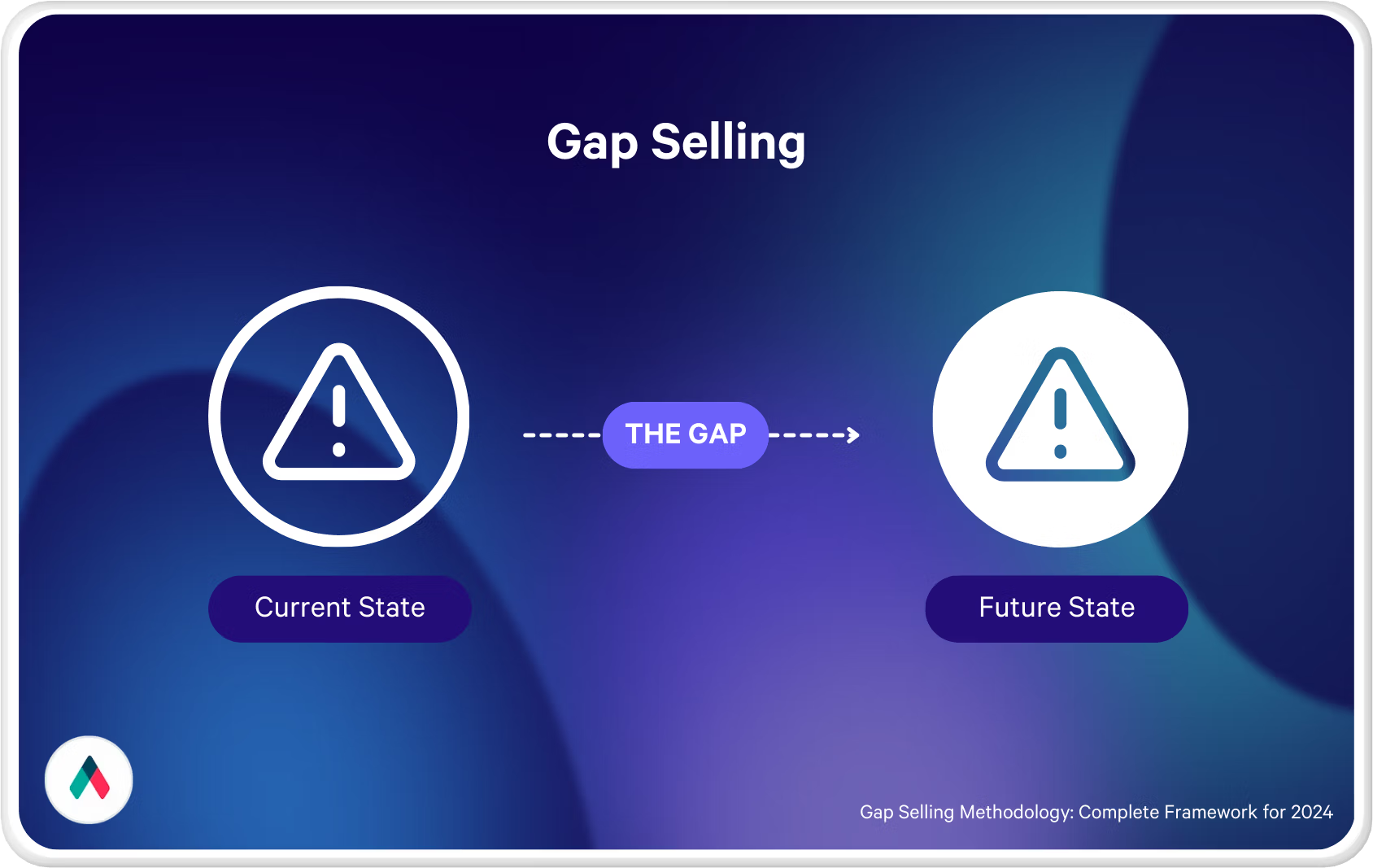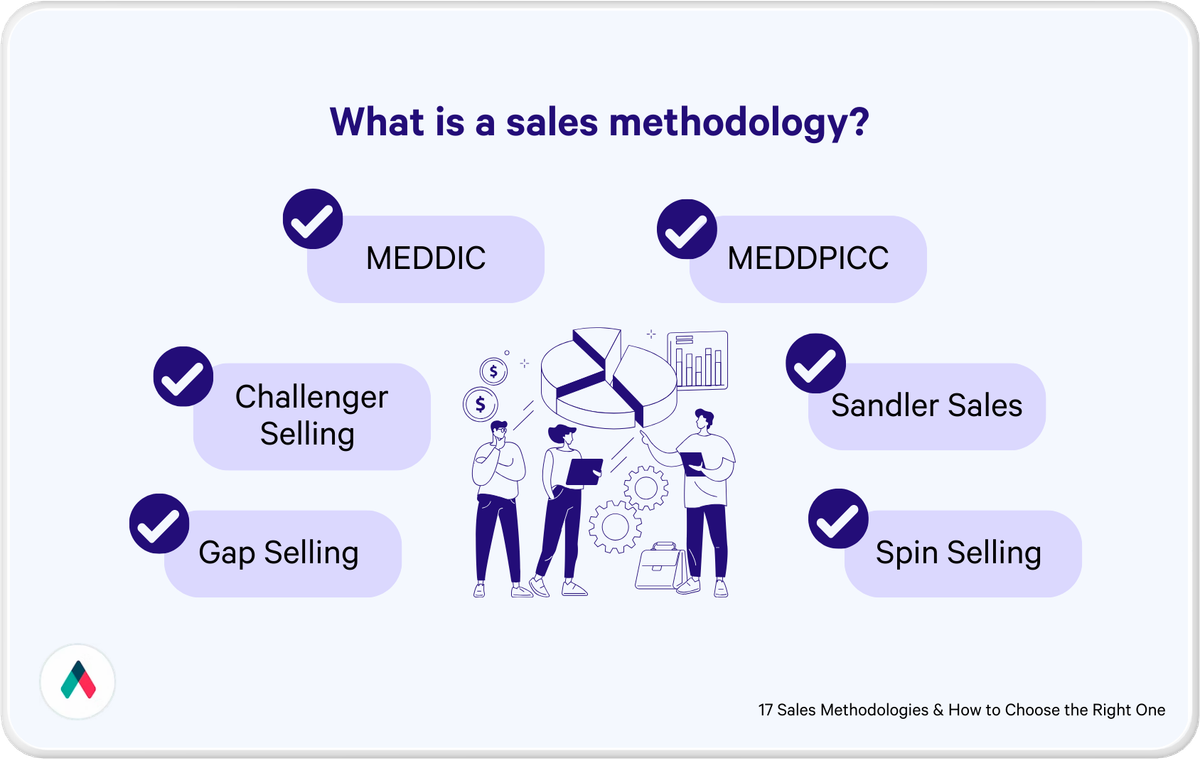In a typical sales scenario, there is a sales team that is charged with bringing a product or service to new customers. Finding and converting the right prospects into paying customers is the name of the game.
While this may seem like a straightforward process, it often does not lead to the desired results— 74% of sales reps fail at sales, according to a survey conducted by Zipia!
Clearly, there's an issue with these traditional processes as they simply scratch the surface, and there are clear “gaps” to fill. In other words, the sales reps lack a deep understanding of the prospect’s “real” issues, the root cause of the problem, its impact, and most importantly, their goals.
If you’ve found yourself nodding along and your sales organization is looking for ways to change this and improve your sales process, then Gap Selling might be the suitable sales methodology for you.
In this ultimate guide, we’ll take you through this novel sales methodology, its pros, and cons, help you identify if gap selling is a good fit for your sales org, and share some tips on getting started.
What is the Gap Selling methodology?
Gap selling is a problem-solving sales methodology developed by renowned sales coach Keenan— CEO of ASG (A Sales Growth Co.) and author of the much-renowned book Gap Selling: Getting the Customer to Yes.
Unlike other sales methodologies like BANT or Spin Selling, Gap Selling focuses on identifying and highlighting the gap between a prospect's current situation and their desired future state. Instead of bombarding potential buyers with generic pitches, Gap Selling encourages salespeople to understand their customer's pain points and aspirations deeply. Knowing them intimately helps sales teams in better forecasting and elevating their sales management.
By doing so, they can effectively position their products or services as the solution that bridges the gap and helps customers achieve their goals.
Gap Selling current vs future state
This buyer-centric approach focuses heavily on understanding the space between your buyer’s current and future state and how you can close this gap for them.

The pros and cons of Gap selling
Sales opportunities thrive within "the gap," and while Gap Selling may look enticing, it won’t work in every situation. That’s why weighing its pros and cons is essential. The pros and cons of this methodology will vary by organization, but here are some of the most common for you to review as you’re evaluating your own list:
| Pros of Gap Selling | Cons of Gap Selling |
|---|---|
Offers customer-centric approach | Time-consuming sales methodology |
Enhanced value proposition | Requires complex implementation |
Higher customer satisfaction through credibility | Offers limited applicability |
Let’s look at them in detail:
Gap Selling advantages
1. A prospect-focused approach
Gap Selling puts the prospect at the center of the sales process, allowing salespeople to understand the prospect or customer’s needs, pain points, and aspirations deeply, making them a trusted advisor. By addressing these gaps, sales reps can position their products or services as the ideal solution and shorten sales cycles.
For example, let's consider your organization sells sales automation software. By adopting a prospect-focused approach, your sales reps can uncover their prospect’s struggles, such as inefficient lead management, lack of visibility into sales pipelines, and manual reporting processes.
2. Enhanced value proposition
By focusing on the gaps, your sales team can demonstrate the unique value your offerings provide, which helps differentiate your products or services from competitors and increases the perceived value in the eyes of the potential customer.
Say you’re offering customer relationship management (CRM) software. With Gap Selling, you can identify gaps in the prospect's current CRM system, such as a lack of integration or inadequate reporting capabilities. You can quickly show a clear value proposition and close quotas by highlighting how your sales software fills these gaps and improves efficiency.
Read next: Miller Heiman sales methodology
3. Higher customer satisfaction
Gap Selling aims to provide tailored solutions to customers' specific challenges and address their pain points directly. Your sales team can ensure higher customer satisfaction and build long-term relationships.
For instance, if you're selling project management services, you can uncover a client's struggle with missed deadlines and poor communication among team members using the Gap-Selling method. By customizing your service to address these gaps and deliver a streamlined project management process, you can significantly enhance customer satisfaction. It’s a win-win.
Gap Selling limitations
1. Time-consuming
Gap Selling requires thorough research and understanding of each prospect’s unique situation, which can be time-consuming, especially when dealing with a large volume of potential prospects, impacting sales productivity. So before you think of implementation, it’s best to evaluate your resources and see if this is an ideal methodology for your business.
2. Complex implementation
Implementing Gap Selling effectively requires sales training and skill development. Salespeople need to develop intense questioning and listening skills and shake off old habits, such as simply rattling features or assuming what the prospect wants.
Asking thought-provoking queries instead will help your sales reps gather valuable insights and understand what makes each buyer tick. Armed with this knowledge, you can tailor your solutions to fit their unique requirements and provide maximum value.
3. Limited applicability
Gap Selling may only be suitable for some sales situations as some industries or products may have straightforward features and benefits, making the gap less apparent.
How do you know if Gap Selling fits your sales organization well?
In his book on Gap Selling, Keenan stresses on how important it is for salespeople to make an effort to understand the challenges and problems their customers are dealing with. He states, “Understanding the customer's world isn't an option; it's a necessity."
This statement forms the foundation of Gap-selling, clearly hinting that this sales methodology is a question-heavy method of knowing your customers and involves a lot of time investment by reps in the discovery phase. If your organization needs more time and resources to train your reps, then Gap selling may not be the ideal sales method, to begin with.
Mark Cope, Chief Revenue Officer at Corestream, realized that training is crucial to the success of Gap-Selling and improved close rates from mid-teens to the mid-twenties at his company, ultimately settling the close rate at 33% after reinforcing the training.
Talking about the right fit, it's also essential to consider the nature of your product or service. Gap Selling is most effective when there is a clear problem or challenge that your offering can solve. However, if your product is more of a luxury or nice-to-have than a necessity, it won’t work as the customers may not enjoy such detailed lines of questioning.
Something else to consider here is the target market. For instance, if you're targeting a market segment that is not actively seeking solutions or unaware of its challenges, the Gap-Selling approach may not resonate effectively as it is built on the premise of understanding the prospect's world and uncovering their pain points. What may work in such cases are education and awareness-building strategies!
Finally, Gap Selling methods do not complement organizations with short sales cycles and are best suited for products (mostly B2B) with longer sales cycles or complex deals.
What are the different types of Gap Selling questions?
In his book, Keenan lists four types of questions in gap selling. These include:
- Probing questions (also referred to as discovery questions) are used to gather information and gain a comprehensive understanding. For example, “What kind of impact is [problem] having on your organization?”
- Process questions are open-ended questions such as "What factors do you consider when evaluating a new software solution for your business?"
- Provoking questions are designed to challenge the customer's existing beliefs and assumptions. For example, "What would happen if you continue with your current strategy without making any changes?"
- Validating questions are close-ended questions used to confirm and validate the customer's pain points, desired outcomes, and the potential value of a proposed solution. An example of this is, “What I hear you saying is [insert problem] is the issue. Is this correct?”
How to get started with Gap Selling
Ready to dive into the world of Gap- Selling? Let’s look at several crucial steps that can guide you towards success.
Whether you're a seasoned sales professional looking to refine your approach or a newcomer to the sales game, these practical tips and insights will help you hit the ground running.
It's quite common to see salespeople diving right into conversations with prospects without really understanding the challenges and issues they're facing—it’s a real struggle for both the salesperson and their prospect.
If you're trying to make a sale but are totally clueless about what your prospects are going through. It's like stumbling around in the dark, desperately searching for a problem to solve. Keenan advises that it's crucial to dig deep and understand their pain points and clearly understand what they're struggling with, what keeps them up at night, and what they genuinely need help with to make a real impact.
And that’s where a problem identification chart comes into the picture.
Here’s an example of what this should look like when it’s filled out correctly:
| Problem | Impact to organization | What I know about the problem |
|---|---|---|
Low close rates | High cost of sales, slow revenue growth, fewer customers, less revenue, less profitability, increased pressure on the base, wasted leads, lost opportunities, vulnerable to competition, etc. | Can be caused by a weak sales team, lack of training, poor sales enablement, poor deal strategies, poor sales management, real product issues, lack of understanding of target customer, poor marketing, wrong target marketing etc. |
Decline in sales | A decline in revenue, lower margin dollars, cash flow challenges, inability to invest in a product or other areas, layoffs, increase in the cost of sales, increased competitive pressures, high turnover, etc. | Can be caused by poor sales management, lack of training, wrong product, wrong sales team with wrong sales skills, shift in the market, lack of process, poor forecasting, misaligned incentives and broken commission structure, weak culture, lack of planning etc. |
Weak lead generation/prospecting | Generation/Prospecting Slow growth, missing quota, weak pipeline, increased cost of sales, pressure on marketing, infighting with marketing, not enough new logos, heavy dependency on the base, single-threaded, increased pressure on close improving close rates etc. | Can be caused by a weak sales team, the inability of the team to diagnose the problem, lack of understanding of solution set and customer environments, poor marketing, no marketing, lack of understanding of the marketplace, weak value proposition, wrong sales team structure (farming and hunting at the same time), compensation misalignment, etc. |
Source: salesgrowth.com
This table outlines the problems your product can solve, its impact and root causes, and it's something that sales reps need to prepare before reaching out to their prospect.
Find your prospect’s biggest problems at present
This stage is all about soaking up as much information as possible about the prospect’s current stage. Think of it as peeling back the layers of an onion and getting to know their business inside out.
It's an opportunity to dig deep and find out how their business operates. What are their pain points? What challenges are they facing? Understanding their strategies or solutions gives you valuable insight into what's working and where there might be opportunities for improvement.
Tempting though it may be, it's not the place to start talking about your product, service or the features and benefits you offer. Using our project management tool, as an example. In this meeting, a sales rep should ask questions like:
- How are you currently managing projects?
- Are you facing any bottlenecks or inefficiencies in the process?
- What challenges do you encounter when collaborating with your team?
By actively listening and understanding their unique situation, you can offer insights and recommendations that directly address their pain points.
Identify the impact of your prospect’s problems
Now that you've got a clear picture of how the prospect's business currently functions, it's time to dive even deeper.
At this stage, you want the prospect to open up and share their thoughts and experiences. Your goal is to help them identify the impact that their problem is having on their own work and the overall success of their organization.
You could ask questions like:
- How has the software (or lack thereof) affected your ability to manage customer relationships effectively?
- Have you noticed any negative impact on sales or customer retention?
- Are there any missed opportunities or delays in your sales pipeline due to the problem?
These questions are designed to encourage the prospect to reflect on the consequences they've faced as a result of the problem.
In addition, it's great to help the prospect in identifying the root cause of the issues. You might have already started this work when you created your problem identification chart, but getting the prospect to participate is even better. It can provide confirmation of what you’ve outlined or show you a root cause you hadn’t even considered.
Encourage them to share their thoughts and insights in their own words and craft the right questions in a way that you get longer answers than short ones!
Understand your prospect’s future state
As you continue the conversation, it’s time to determine your prospect's future state. This involves exploring the environment they want to create and how their ideal outcome would affect them emotionally. It's all about painting a vivid picture together.
You could ask questions like:
- Why is finding this kind of solution so vital?
- How would it make you feel?
Let's take a B2B marketing software example to bring this to life. Imagine you're selling a marketing automation platform. You could ask questions like,
- How would having an efficient and automated marketing process impact the team's morale?
- What would it mean for you to achieve your goals with ease and precision?
By tapping into the emotions tied to their ideal outcome, you better understand their motivations and desires. If your prospect mentions an outcome they'd like to achieve, don't hesitate to ask why it's important to them. Understanding their priorities will guide you in determining what truly matters to them.
Identify the decision-making process
Before you unveil your brilliant solution, you must have a solid grasp of how the buying decision will unfold. You want to know about the criteria that the buying team is prioritizing and how the entire process will play out.
And that’s where validating questions come to the rescue! These questions are incredibly handy because they help you confirm and validate your understanding of the decision-making process and allow you to have a clear picture of all the steps and players involved, enabling you to address them seamlessly when you present your solution to the prospects. Some examples of validating questions you can ask are:
- What are the specific criteria the buying team prioritizes in their evaluation? Is it cost-effectiveness, ease of implementation, scalability, or other factors?
- Who are the key decision-makers and influencers in the buying process? Are there specific individuals who hold veto power or have significant influence over the final decision?
- Are there any specific milestones or stages in the decision-making process that you must be aware of? For example, will there be a formal presentation or a trial period?
- Are there any budgetary constraints or financial considerations that need to be addressed? Who will be responsible for signing off on the purchase?
Close the gap
The last step of implementing gap selling is closing the gap. Once you completely understand the prospect, their needs, and their desired outcome, you can pitch your product as their best option.
The three points Keenan highlights when closing the gap allow salespeople to highlight the aspects that truly matter to them.
Highlighting key features
Sure, your product may have a plethora of amazing capabilities, but not all of them will be relevant to every prospect. Keenan advises narrowing it down to a small handful of features, ideally at most six that most likely resonate with their specific needs and desires.
Anchoring your prospects
Once you've just showcased a fantastic software feature that can work wonders for their business, it's time to spark their imagination and enthusiasm by asking a thought-provoking question.
Something like, "Can you see how this awesome feature can help you address the challenge of frequent project delays?" By doing this, you're planting the seeds of possibility in their minds, and they'll start envisioning a brighter future state with your solution.
Focusing on business problems, not technicalities
Keenan states that the secret to closing sales deals lies in emphasizing how your software is the perfect solution to their specific business problem.
Let's say you're selling a marketing automation platform. Rather than delving into technical jargon about integrations, emphasize how your software can help them combat high churn rates or boost their declining sales. Addressing their business challenges and demonstrating the real-world impact of your solution will speak volumes to your prospects.
Next, let's cover how understanding the psychological impact of Gap Selling can significantly enhance how sales teams and customers perceive and react to the sales process.
The psychological impact of Gap Selling on Sales Teams and Customers
The psychological impact of Gap Selling extends beyond simple sales techniques, influencing both the mindset of sales teams and the behavior of customers.
For sales teams: Gap Selling cultivates a consultative sales mindset, shifting focus from mere selling to solving customer problems. This shift not only enhances job satisfaction but also builds a deeper sense of purpose and connection with customers.
For customers: Gap Selling fosters trust and reliability. Customers feel understood and valued when sales reps take the time to identify and address their specific needs. This personalized approach reduces the perceived risk of purchase, as customers are more confident that the offered solutions will meet their expectations.
Moreover, the focus on long-term relationships rather than one-off sales ensures that customers experience consistent support, enhancing loyalty and reducing churn. The psychological comfort of knowing they have a partner in their success story encourages ongoing engagement with the brand.
By recognizing and harnessing these psychological impacts, companies can create a more supportive and effective sales environment that benefits both the organization and its customers, fostering a positive cycle of engagement and satisfaction.
Gap Selling proposal template
Using a specialized Gap Selling Proposal Template can significantly streamline your sales process by aligning your sales pitch with the Gap Selling methodology. This proposal template helps organize the sales proposal, ensuring it highlights the gap between the customer's current state and their desired future state and demonstrates how your product or service bridges this gap.
Many Qwilr customers utilize our proposal software solution to craft engaging sales pitches, and this Gap Selling Template is designed to optimize your presentations for maximum impact. It includes:
- Executive summary following the gap selling framework
- Product value prop
- Product value section
- Interactive pricing
- Team information
- Customer testimonials
- Acceptance of terms
- Contact us information
Final thoughts
Impressed by the Gap Selling methodology? You aren’t alone. The ability to deeply understand a prospect’s business, goals, and issues and offer a solution based on it is a powerful problem-centric approach to selling. But it means that your sales team will be digging deep into customers’ problems and their needs which makes it a methodology fit for those who are ready to go all out and not for those focussed on short-term sales strategy.
Is that you? If yes, try out our tips and use this Gap Selling template to get started.
FAQs
Challenger sale and gap selling are two distinct sales methodologies that offer unique approaches to driving success.
Gap Selling involves identifying and addressing the gap between a prospect's current situation and their desired future state. With gap selling, you would deeply understand their pain points and gaps and position your offering as the ideal solution to a prospect’s specific challenges.
Challenger selling takes a different approach. It focuses on challenging the customer's existing thinking and introducing new perspectives - effectively challenging the status quo.
Closing the customer gap in gap-selling involves thoroughly understanding the prospect's needs, aligning your solution with their pain points, and effectively presenting the value and benefits of your offering. When doing so, highlight key features, anchor your prospects, and focus on business problems than technicalities.
In his book, Keenan lists four types of questions in gap selling. These include:
- Probing questions (also referred to as discovery questions) are used to gather information and gain a comprehensive understanding. For example, “What kind of impact is [problem] having on your organization?”
- Process questions are open-ended questions such as "What factors do you consider when evaluating a new software solution for your business?"
- Provoking questions are designed to challenge the customer's existing beliefs and assumptions. For example, "What would happen if you continue with your current strategy without making any changes?"
- Validating questions are close-ended questions used to confirm and validate the customer's pain points, desired outcomes, and the potential value of a proposed solution. An example of this is, “What I hear you saying is [insert problem] is the issue. Is this correct?”









